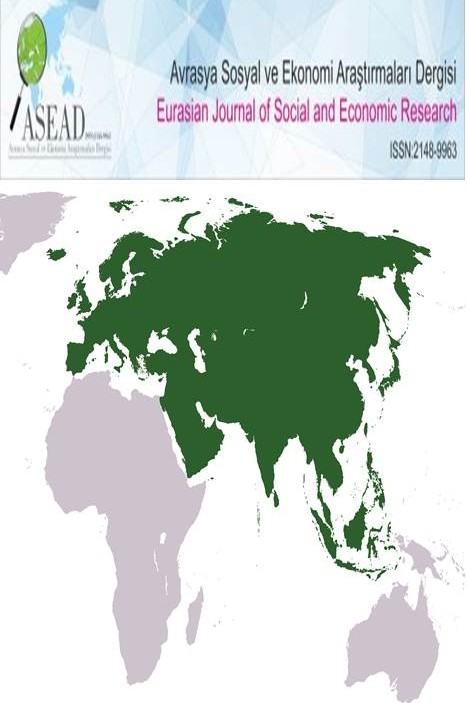THE POSSIBILITIES OF USING GAMIFICATION ELEMENTS IN TEACHING MATHEMATICS
mathematics, education, learners, gamification, game technology
___
- 1. Dooley, T., Dunphy, E., Shiel, G., Butler, D., Corcoran, D., Farrell, T.,…Perry, B. (2014). Mathematics in early childhood and primary education (Children aged 3–8 years): Teaching and learning. Dublin, Ireland: National Council for Curriculum and Assessment
- 2. Vygotsky L. C. Play and its role in the mental development of the child. // Voprosy psikhologii, 1966. No. 6. S. 42-56
- 3. Davydov V. V. The problem of developmental education. - M., Pedagogy, 1986. - 275 p.
- 4. Zhumabaev, Magzhan. Pedagogy / M. Zhumabayev. - Almaty: Mother tongue, 1992. - 160 pages.
- 5. Ushinsky K. D. Selected pedagogical works. -M., 1968. S. 140-141
- 6. Igna O. N. Imitation (modeling) technology in the professional methodological training of a teacher of a foreign language // Vestn. Tomskogo Gos. ped. (TSPU Bulletin). 2011. Vyp. 9 (111). S. 186–190.
- 7. Dobychyna N. V. "Computer games - theater of active actions" // Philosophical problems of information technologies and cyberspace. 2013. No. 1. S. 149–158.
- 8. Orlova O. V., Titova V. N. Gamification as a way of organizing training // Vestnik TSPU (TSPU Bulletin). 2015. 9 (162) P. 60-64
- 9. Melwin, M., Merry, J., & Chiramel, J. (2017). Fun is the future: A collection of compelling gamification success stories. New Delhi, India: Education Publishing.
- 10. Seaborn, K., & Fels, D. I. (2015). Gamification in theory and action: A survey. International Journal of Human-Computer Studies, 74, 14–31. http://doi.org/10.1016/j.ijhcs.2014.09.006
- 11. Wiki-gamification. URL: https://wiki5.ru/wiki/Gamification (access date: 20.02.2022).
- 12. Gamification // Wikipedia - the free encyclopedia. URL: https://ru.wikipedia.org/ wiki/Igofikatsiya (access date: 21.02.2022)
- 13. Wood L. C. & Reiners T. (2015). Gamification. In M. Khosrow-Pour (Ed.), Encyclopedia of Information Science and Technology (3 rd ed., pp. 3039-3047). Hershey, PA: Information Science Reference. DOI: 10.4018/978-1-4666-5888-2.ch297
- 14. Bozkurt A., & Genç-Kumtepe E. (2014). Gameplay, game philosophy and education: Gamification. Paper presented at the Akademik Bilişim Conference, February 5-7. http://ab.org.tr/ab14/bildiri/233.pdf
- 15. Sezgin S., Bozkurt A., Yılmaz E. A., & Van der Linden N. (2018). Gamification, education and theoretical approaches: Motivation, engagement and sustainability in learning processes. Mehmet Akif Ersoy University Journal of Education Faculty, (45), 169-189. https://doi.org/10.21764/maeuefd.339909
- 16. Dominguez A., Saenz-de-Navarrete J., de-Marcos L., Fernandez-Sanz L., Pages C., & Martinez-Herraiz J. (2013). Gamifying learning experiences: Practical implications and outcomes. Computers & Education, 63, 380-392. https://doi.org/10.1016/j.compedu.2012.12.020
- 17. Hamari J., Koivisto J., & Sarsa H. (2014). Does Gamification Work? – A Literature Review of Empirical Studies on Gamification. In proceedings of the 47th Hawaii International Conference on System Sciences, Hawaii, USA, January 6-9, 2014.
- 18. Herger M. Enterprise Gamification. 2012. URL: http://enterprise-gamification.com/index.php/de/blog/4-blog/79-the-gamification-tipping-point (accessed 12.03.2023).
- 19. Fazilzyanova G.I., Sokolova T.Yu., Balalov V.V. Trends of gamification in educational communications of a digital society // Economic and social-humanitarian studies № 1 (29) 2021 C.105-110. DOI:10.24151/2409-1073-2021-1-105-110
- 20. Evdokimova V.E., Kirillova O.A., Zhdanova E.A. Possibilities of services for the creation of interactive educational materials // Scientific review. Pedagogical sciences. - 2022. - No. 6. - P.10-15; URL: https://science-pedagogy.ru/ru/article/view?id=2452 (access date: 04/24/2023).
- 21. Bijieva S.H., Urusova F.A.-A. Gamification of education: problems of use and perspectives of development // Mir nauki. Pedagogy and psychology, 2020 No. 4, https://mir-nauki.com/PDF/34PDMN420.pdf
- 22. Zamyatina O. M., Mozgaleva P. I., Yurutkina T. Yu. Application of game technologies in "physics" and "mathematics" modules // Scientific and methodological electronic magazine "Concept". - 2015. - Vol. 15. - S. 46–50. – URL: http://e-koncept.ru/2015/95151.htm.
- 23. Eichhorn MV. Gamification of the educational process // Methodological manual under the editorship. Eichhorn M.V. - Tomsk 2015. 39 p. URL:https://toipkro.ru/content/files/ documents/podrazdeleniya/pip/geymifikatsia_obrazovatelnogo_protsesa.pdf
- Yayın Aralığı: Yılda 4 Sayı
- Başlangıç: 2014
- Yayıncı: İrfan TÜRKOĞLU
PROBLEMS OF NOUN AND VERB ROOT WORDS IN THE KAZAKH LANGUAGE
Zhuzimkul BAİYMBETOVA, Kenzhegul KAZİBAYEVA
METHODS OF DEVELOPING INTERDISCIPLINARY COMMUNICATION IN TEACHING NATURAL SCIENCES
DESIGN AND RESEARCH ACTIVITY OF STUDENTS AS A PEDAGOGICAL PROBLEM
USING COMPLEX CONJUNCTIONS IN SOLVING NONLINEAR BOOLEAN EQUATIONS
FEATURES OF TEACHING ROBOTICS TO PRIMARY SCHOOL STUDENTS IN THE CONTEXT OF SMART EDUCATION
Nurlan KARATAYEV, Almira IBASHOVA
GRAPHICS CAPABILITIES IN PYTHON
Gulnur ABDİMANAPOVA, Lazzat ZHAİDAKBAYEVA, Sapargali ALDESHOV
ARNAVUT ÂLİM HAFIZ ALİ KORÇA’NIN TEFSİR ÇALIŞMALARI
Roza KADİRBAYEVA, Baktygul ALİMKULOVA, Madina JAMANKARAYEVA, Kuralay ATİRBEK
DEVELOPMENT OF A MASSIVE OPEN ONLINE COURSE WITH ELEMENTS OF GAMIFICATION
